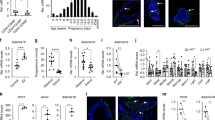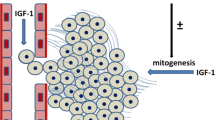Abstract
Stromal-epithelial interactions modulate growth and development in normal and neoplastic mammary gland. The release of IGF binding proteins (IGFBPs) by the stromal compartment of the mammary gland may play a modulating role in the IGF-mediated proliferation of mammary epithelium. Therefore, the IGFBP-expression pattern of the canine mammary tumor cell line U335 (CMT-U335), which has a mesenchymal phenotype, was determined. In addition, the effects of IGFs and all trans retinoic acid (RA) on DNA synthesis, and IGFBP secretion and distribution were examined. The IGFBPs secreted by CMT-U335 were characterized as IGFBP-2, -4, -5, and -6. Moreover, CMT-U335 appeared to be a suitable mammary mesenchymal cell line for study of the regulatory factors of IGFBP expression and the mechanism(s) involved. IGFs and RA enhanced IGFBP concentrations in cell-conditioned medium with IGF-I and RA having an additive effect. The IGF-I-stimulated DNA synthesis, however, was inhibited by RA. The difference between IGF-I and RA was an enhanced IGFBP-5 binding to the extracellular matrix (ECM) by RA, whereas IGF-I reduced binding to the ECM. Because high doses of insulin had no significant effects on IGFBP concentrations in the medium, it is concluded that IGF-I-induced changes in IGFBP concentrations are not mediated by type-I IGF receptors and may be the consequence of IGFBP redistribution.
Similar content being viewed by others
References
Bostock DE: The prognosis following the surgical excision of canine mammary neoplasms. Eur J Cancer 11: 389–396, 1975
Owen LN, Briggs MH: Contraceptive steroid toxicology in the beagle dog and its relevance to human carcinogenecity. Curr Med Res Opin 4: 309–329, 1976
El Etreby MF, Gråf KJ: Effect of contraceptive steroids on mammary gland of female dog and its relevance to human carcinogenecity. Pharmacol Ther 5: 369–402, 1979
Casey HW, Giles RC, Kwapien RP: Mammary neoplasms in animals. Pathologic aspects and the effect of contraceptive steroids. Recent Results. Cancer Res 66: 129–160, 1979
Misdorp, W: Progestagens and mammary tumors in dogs and cats. Acta Endocrinol 125: 27–31, 1991
Rutteman GR: Contraceptive steroids and the mammary gland: Is there a hazard? Insights from animals studies. Breast Cancer Res Treat 23: 29–41, 1992
Concannon PW, Altszuler N, Hampshire J, Butler WB, Hansel W: Growth hormone, prolactin, and cortisol in dogs developing mammary nodules and an acromegalic-like appearance during treatment with medroxy-progesterone acetate. Endocrinology 106: 1173–1177, 1980
Rijnberk A, Eigenmann JE, Belshaw BE, Hampshire J, Altszuler N: Acromegaly associated with transient overproduction of growth hormone in a dog. J Am Vet Med Assoc 177: 534–537, 1980
Eigenmann JE, Rijnberk A: Influence of medroxyprogesterone acetate (Provera) on plasma growth hormone levels and on carbohydrate metabolism: I. Studies in the ovariohysterectomized bitch. Acta Endocrinol 98: 599–602, 1981
Selman PJ, Mol JA, Rutteman GR, Rijnberk A: Progestininduced growth hormone excess in the dog originates in the mammary gland. Endocrinology 134: 287–292, 1994
Mol JA, van Garderen E, Selman PJ, Wolfswinkel J, Rijnberk A, Rutteman GR: Growth Hormone mRNA in mammary gland tumors of dogs and cats. J Clin Invest 95: 2028–2034, 1995
Daughaday WH, Rotwein P: Insulin-like growth factors I and II. Peptide, messenger ribonucleic acid and gene structures, serum, and tissue concentrations. Endocr Rev 10: 68–91, 1989
Jones JI, Clemmons DR: Insulin-like growth factors and their binding proteins: biological actions. Endocr Rev 16: 3–35, 1995
Pekonen F, Nyman T, Ilvesmåki V, Partanen S: Insulinlike growth factor binding proteins in human breast cancer tissue. Cancer Res 52: 5204–5207, 1992
Figueroa JA, J ackson JG, McGuire WL, Krywicki RF, Yee, D: Expression of insulin-like growth factor binding proteins in human breast cancer correlates with estrogen receptor status. J Cell Biochem 52: 196–205, 1993
McGuire SE, Hilsenbeck SG, Figueroa JA, Jackson JG, Yee D: Detection of insulin-like growth factor binding proteins (IGFBPs) by ligand blotting in breast cancer tissues. Cancer Lett 77: 25–32, 1994
Clemmons DR, Camacho-Hübner C, Coronado E, Osborne CK: Insulin-like growth factor binding protein secretion by breast carcinoma cell lines: correlation with estrogen receptor status. Endocrinology 127: 2679–2686, 1990
Jetten AM: In: Guroff, G (ed) Growth and Maturation Factors. Vol 3. Wiley, New York, 1985, pp. 252–293
Fontana JA, Burroes-Mezu A, Clemmons DR, LeRoith D: Retinoid modulation of insulin-like growth factor binding proteins and inhibition of breast carcinoma proliferation. Endocrinology 127: 1115–1122, 1991
Adamo ML, Shao Z-M, Lanau F, Chen J-C, Clemmons DR, Roberts CT, LeRoith D, Fontana JA: Insulin-like growth factor-I (IGF-I) and retinoic acid modulation of IGF-binding proteins (IGFBPs): IGFBP-2,-3, and-4 gene expression and protein secretion in a breast cancer cell line. Endocrinology 131: 1859–1867, 1992
Sheikh MS, Shao Z-M, Hussain A, Clemmons DR, Chen J-C, Roberts CT, LeRoith D, Fontana JA: Regulation of insulin-like growth factor binding protein-1, 2, 3, 4, 5, and 6: synthesis, secretion, and gene expression in estrogen receptor-negative human breast carcinoma cells. J Cell Physiol 155: 556–567, 1993
Sheikh MS, Shao Z-M, Hussain A, Chen J-C, Roberts CT, LeRoith D, Fontana JA: Retinoic acid and estrogen modulation of insulin-like growth factor binding protein-4 gene expression and the estrogen receptor status of human breast carcinoma cells. Biochem Biophys Res Commun 193: 1232–1238, 1993
Haslam SZ: Stromal-epithelial interactions in normal and neoplastic mammary gland. Cancer Treat Res 53: 401–420, 1991
Woodward TL, Xie JW, Haslam SZ: The role of mammary stroma in modulating the proliferative response to ovarian hormones in the normal mammary gland. J MamGland Biol Neoplasia 3: 117–131, 1998
Nap RC, Mol JA, Hazewinkel HAW: Age-related plasma concentrations of growth hormone and insulin-like growth factor in Great Dane pups on different levels of protein intake. Domestic Animal Endocrinol 10: 237–247, 1993
Mol JA, Selman PJ, Sprang EPM, Oosterlaken-Dijksterhuis MA, van Neck JW: IGF and IGF binding protein in plasma and mammary tissue of dogs with progestin induced growth hormone excess. In: Effects of Progestin Administration in the Dog. Thesis, Chapter 9, Utrecht University, Utrecht, 1995
van Zoelen EJJ, van Oostwaard TMJ, van der Saag PT, de Laat SW: Phenotypic transformation of normal rat kidney cells in a growth-factor-defined medium: induction by a neuroblastoma-derived transforming growth factor independently of the EGF receptor. J Cell Physiol 123: 151–160, 1985
Knudsen BS, Harpel PC, Nachman RL: Plasminogen activator inhibitor is associated with the extracellular matrix of cultured bovine smooth muscle cells. J Clin Invest 82: 1082–1089, 1987
Laemmli UK: Cleavage of structural proteins during the assembly of the head of bacterophage T4. Nature 227: 680–685, 1970
Maniatis T, Fritsch EF, Sambrook J: Molecular Cloning, A Laboratory Manual, Cold Spring Harbor Laboratory Press, Cold Spring Harbor, NY, USA, 1982
Cohick WS, Clemmons DR: The insulin-like growth factors. Annu Rev Physiol 55: 131–153, 1993
Rechler MM, Brown AL: Insulin-like growth factor binding proteins: gene structure and expression. Growth Regulation 2: 55–68, 1992
Grellier P, Yee D, Gonzalez M, Abboud SL: Characterization of insulin-like growth factor binding proteins (IGFBP) and regulation of IGFBP-4 in bone marrow stromal cells. Br J Haematol 90: 249–257, 1995
Kelley KM, Oh Y, Gargosky SE, Gucev Z, Matsumoto T, Hwa V, Ng L, Simpson DM, Rosenfeld RG: Insulin-like growth factor binding proteins (IGFBPS) and their regulatory dynamics. Int J Biochem Cell Biol 28: 619–637, 1996
Clemmons DR: Insulin-like growth factor binding proteins and their role in controlling IGF actions. Cytokine Growth Factor Rev 8: 45–62, 1997
Shemer J, Yaron A, Shao ZM, Sheikh MS, Fontana JA, LeRoith D, Roberts CT: Regulation of insulin-like growth factor (IGF) binding protein-5 in the T47D human breast carcinoma cell line by IGF-I and retinoic acid. J Clin Endocrinol Metab 77: 1246–1250, 1993
Martin JL, Coverley JA, Pattison ST, Baxter RC: Insulinlike growth factor binding protein-3 production by MCF-7 breast cancer cells: stimulation by retinoic acid and cyclic adenosine monophosphate differential effects of estradiol. Endocrinology 136: 1219–1226, 1995
Martin JL, Coverley JA, Baxter RC: Regulation of immunoreactive insulin-like growth factor binding protein-6 in normal and transformed human fibroblasts. J Biol Chem 269: 11470–11477, 1994
Dong Y, Canalis E: Insulin-like growth factor (IGF) I and retinoic acid induce the synthesis of IGF-binding protein 5 in rat osteoblastic cells. Endocrinology 136: 2000–2006, 1995
Zhou Y, Mohan S, Linkhart TA, Baylink DJ, Strong DD: Retinoic acid regulates insulin-like growth factor binding protein expression in human osteoblast cells. Endocrinology 137: 975–983, 1996
Jones JI, Gockerman A, Busby WH, Camacho-Hübner C, Clemmons DR: Extracellular matrix contains insulin-like growth factor binding protein-5: potentiation of the effects of IGF-I. J Cell Biol 121: 679–687, 1993
Schmid C, Schlapfer I, Gosteli-Peter MA, Froesch ER, Zapf J: Effects and fate of human IGF-binding protein-5 in rat osteoblast cultures. Am J Physiol 271: E1029–E1035, 1996
Mohan S, Nakao Y, Honda Y, Landale E, Leser U, Dony C, Lang K, Baylink DJ: Studies on the mechanisms by which insulin-like growth factor (IGF) binding protein-4 (IGFBP-4) and IGFBP-5 modulate IGF actions in bone cells. J Biol Chem 270: 20424–20431, 1995
James PL, Stewart CE, Rotwein P: Insulin-like growth factor binding protein-5 modulates muscle differentiation through an insulin-like growth factor-dependent mechanism. J Cell Biol 133: 683–693, 1996
Reeve JG, Guadano A, Xiong J, Morgan J, Bleehen NM: Diminished expression of insulin-like growth factor (IGF) binding protein-5 and activation of IGF-mediated autocrine growth in simian virus 40-transformed human fibroblasts. J Biol Chem 270: 135–142, 1995
Verschure PJ, van Noorden CJF, van Marle J, van den Berg WB: Articular cartilage destruction in experimental inflammatory arthritis: insulin-like growth factor-1 regulation of proteoglycan metabolism in chondrocytes. Histochem J 28: 835–857, 1996
Morales TI: Transforming growth factor-beta and insulinlike growth factor-1 restore proteoglycan metabolism of bovine articular cartilage after depletion by retinoic acid. Arch Biochem Biophys 315: 190–198, 1994
Oh Y: IGF-independent regulation of breast cancer growth by IGF binding proteins. Breast Cancer Res Treat 47: 283–293, 1998.
Author information
Authors and Affiliations
Rights and permissions
About this article
Cite this article
Oosterlaken-dijksterhuis, M.A., Kwant, M.M., Slob, A. et al. IGF-I and retinoic acid regulate the distribution pattern of IGFBPs synthesized by the canine mammary tumor cell line CMT-U335. Breast Cancer Res Treat 54, 11–23 (1999). https://doi.org/10.1023/A:1006107703745
Issue Date:
DOI: https://doi.org/10.1023/A:1006107703745




